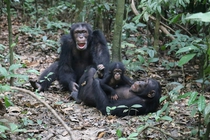

Chimpanzees in Taï National Park, Côte d'Ivoire.
Source: Liran Samuni/ Taï Chimpanzee Project
Anthrax, a disease so far not associated with tropical rain forests, is common in the Ivory Coast’s Taï National Park and is posing a serious threat to wildlife there. The bacterium could soon even cause the extinction of local chimpanzee populations.
This is revealed in a study by scientists from the Robert Koch Institute (RKI), the Max-Planck Institute for Evolutionary Anthropology, the University of Glasgow, and the Ivorian National Animal Health Institute to appear on 3 August 2017 in the journal Nature („Persistent anthrax as a major driver of wildlife mortality in a tropical rainforest“).
“The results demonstrate the importance of long-term studies of infectious diseases and their effects on wildlife”, says RKI’s Fabian Leendertz, the veterinary scientist leading the study. “They help us to better protect endangered species. But at the same time, infections in great apes are often indicators of diseases that can also affect humans”. Lothar H. Wieler, president of the RKI and co-author, adds: “The work really highlights the One Health approach that sees human and animal health as intimately connected and stresses the need for considering them jointly.”
Anthrax is caused by spore-forming bacteria, typically Bacillus anthracis. Especially in the arid regions of Africa, outbreaks are common and can also affect people and their livestock. In 2004, Leendertz’ team at RKI discovered a previously unknown type of the anthrax bacterium in dead chimpanzees in the rainforests of Taï National Park: Bacillus cereus biovar anthracis. Studies conducted since have shown that the same type has also caused mortality in isolated cases in chimpanzees, gorillas, and elephants in Cameroon and the Central African Republic.
In their current work, the researchers focussed on the distribution of the pathogen within Taï National Park and its effect on wildlife populations. They analysed bone and tissue samples which had been collected over the last 28 years from mammal carcasses found in the park.
They also looked at the stomach content of carrion flies: these flies constantly encounter carcasses, pick up the anthrax pathogen, and can thus provide clues about the areas and species it circulates in. Bones and flies from 16 other regions in sub-Saharan Africa were also tested. Sequencing and analysing the pathogen’s genome, which also involved scientists at the University of Glasgow, enabled establishment of how animal cases were linked.
“To our surprise, almost 40 percent of all animal deaths in Taï National Park we investigated were attributable to anthrax,” reports Emmanuel Couacy-Hymann from the Ivorian National Animal Health Institute. The researchers found the pathogen in several monkey species, duikers, mongoose, and a porcupine. Most seriously affected were the chimpanzees: 31 of the 55 individuals whose carcasses were examined had died from the disease.
“According to our projections, anthrax could over time contribute to drive chimpanzees in Taï National Park to extinction,” says Roman Wittig, who leads the Taï Chimpanzee project at the Max-Planck Institute for Evolutionary Anthropology. The scientists are now trying to find out why the pathogen is particularly active in Taï National Park; they also still don’t know where and how animals become infected. In addition, the researchers are searching for ways to protect the chimpanzees, including the possibility of vaccination.
Human infections with the atypical type of the anthrax bacterium have so far not been reported. But the probability that it also poses a threat to humans, just like Bacillus anthracis, is high, since both types are highly related. Collaborative studies between RKI and research institutes and agencies in Ivory Coast to investigate this are currently under way. Anthrax in humans can cause death but if recognised early can usually be treated successfully with antibiotics.
Pictures of the scientists’ work and chimpanzees in Taï National Park can be downloaded at http://www.rki.de/DE/Content/Service/Presse/Pressefotos/Milzbrand-Tab2.html.
Further information:
• Robert Koch Institute, project group “Epidemiology of Highly Pathogenic Microorganisms: www.rki.de/p3-en
• Max Planck Institute for Evolutionary Anthropology, Department of Primatology: http://www.eva.mpg.de/primat
• University of Glasgow, Institute of Biodiversity Animal Health and Comparative Medicine: http://www.gla.ac.uk/researchinstitutes/bahcm/
Publisher
Robert Koch Institute
Nordufer 20
D-13353 Berlin
www.rki.de
Twitter: @rki_de
Press office
Susanne Glasmacher
(Press Officer)
Günther Dettweiler
Marieke Degen
(Deputy Press Officers)
Heidi Golisch
Claudia Paape
Judith Petschelt
Contact
Tel .: 030-18754-2239, -2562 and -2286
E-mail: presse@rki.de
The Robert Koch Institute is a federal institute within the portfolio of the German Federal Ministry of Health















